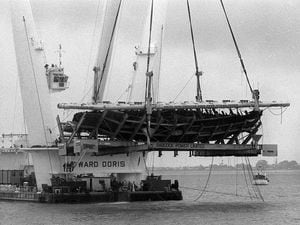Flashback to October 1982: Mary Rose is brought back to the surface
Audiences around the world watched in awe as the Mary Rose, flagship of King Henry VIII, was raised to the surface after 437 years at the bottom of the Solent.

The long-anticipated £4 million operation, twice postponed, was beset by technical problems with the complicated salvaging apparatus and floating cradle.
But the ship's skeletal remains of mud-caked timber were in the end successfully re-floated, enabling experts to begin the long process of restoring the Mary Rose in a dry dock in Portsmouth.
The lifting of the Mary Rose created unprecedented interest across the UK.
Even in the landlocked Midlands, schools set up TV screens for children to watch.
The operation was screened live at breakfast time on the BBC, a full year before early morning scheduled programmes started.
Launched in 1510, the Mary Rose sank on its way to engage the French enemy fleet off Portsmouth Sound in 1545.
Most marine historians believe her sinking was simply the result of a handling error. At the time the French assumed it was their cannons. Between four and five hundred men perished.
She is unique as a transitional ship between mediaeval "floating castles" and Elizabeth I's navy galleons.
19th century Royal Engineers blew up part of the Mary Rose as a "hazard to shipping". In 1980 RE divers began helping to raise the wreck to "atone" for their predecessors' work.
One the day she was raised, a flotilla of boats had gathered off Portsmouth on the south coast of England to witness the occasion.
With the ship already suspended underneath a lifting frame, today's work required raising the wreck in a specially crafted air-cushioned cradle.
Lifting of the wreck from its location at 50 feet below sea level began at 0700 local time and within two hours the first jagged edges of timber had broken the surface.
A cannon was fired from the ramparts of Southsea Castle to signal the historic moment.
Yet just before midday one of the pins holding the lifting frame sheared, a steel line snapped and part of the 80 tonne frame smashed down on the hull.

Speaking after the accident, Prince Charles, President of the Mary Rose Trust, and a seasoned diver at the wreck spoke of his shock:
"I was slightly horrified but I thought the best thing to do was to be British and not panic."
Inspections showed the damage to be slight, but further mishaps meant the wreck was not safely installed onto its transport barge until 1500.
Margaret Rule, archaeological director of the privately-sponsored project said the raising of the "fascinating and rare Tudor artefact" was the culmination of a "dream that had gripped the imagination of the world".
The Mary Rose was rediscovered in 1966 by Alexander McKee, a historian and amateur diver.
Since then over 10,000 well-preserved items have been excavated including weapons, clothes and even a backgammon set.
After the Mary Rose was raised, the hull was kept in highly protective surroundings, firstly with a fine spray of chilled water followed by a water-soluble wax until April 2013 when it was kept in a state of controlled air-drying.
The completion of the drying and the removal of the glass screens is seen as the culmination of the £39 million project to conserve the ship and produce an “awe-inspiring” visitor experience to tell the story of the ship which went down with 500 men on board and only 35 surviving.

In 2016, the hull was revealed at a special viewing at Portsmouth Historic Dockyard held on the 471st anniversary of the sinking of the Mary Rose.
Historian David Starkey said: “For the first time we can actually see the Mary Rose. Up to this point from the moment it was brought up in the 1980s, it has been in a state of both being preserved and conserved and to do that it had to be covered by sprays, it had to be put in a huge bag like a condom and then it had to be dried.
“And while of all that went on, there were obstacles between you, the visitor, and the ship.
“Now all of that has been taken away and you can see the thing, it’s there, it’s a three-dimensional object.”
Helen Bonser-Wilton, chief executive of the Mary Rose Trust, said: “The story of the Mary Rose spans almost 500 years and this is a very exciting close to the latest chapter in her history.
“Visitors will have stunning panoramic views of the ship from all nine galleries.
“This is the culmination of decades of hard work by the Mary Rose team and we can’t wait to share this stunning new experience with everyone.”





